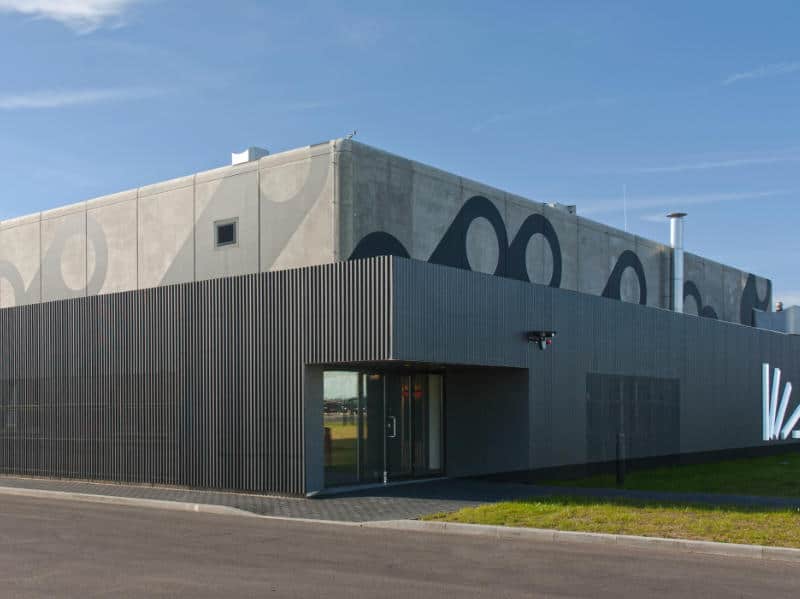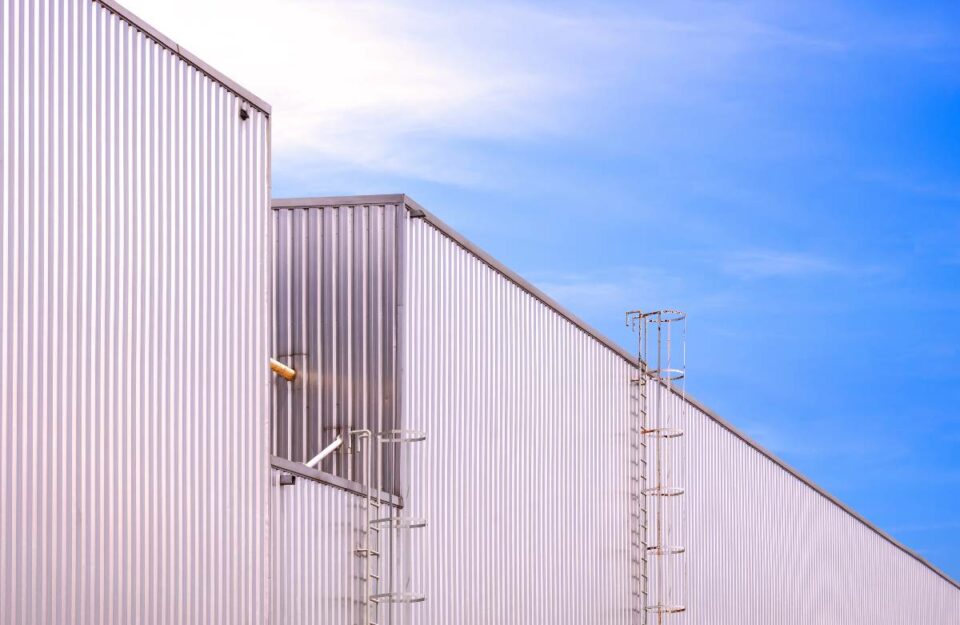After years in LA’s industrial trenches, I’ve seen how the right property can transform a business or investment. With construction costs climbing and market conditions shifting weekly, today’s market rewards those with insider knowledge. I’ve guided clients through these exact challenges, turning complex dynamics into strategic advantages that impact their bottom line. Let me help you navigate with confidence.
Key Takeaways
- The Los Angeles industrial market is shifting toward smaller buildings under 50,000 square feet, with properties in Vernon, Commerce, and South Gate seeing the highest demand from local and regional operators.
- California’s Assembly Bill 98 will impose significant new requirements on industrial properties over 100,000 square feet starting January 2026, including mandatory electrification, solar installation, and community protection measures.
- Working with an experienced Commercial Real Estate Broker can help both property owners maximize their investment value and businesses find the ideal space that balances location, features, and regulatory compliance.
The Current Los Angeles Industrial Market
The Los Angeles industrial landscape is experiencing a significant shift. Demand has noticeably moved toward smaller buildings—particularly those under 50,000 square feet. This trend is especially prominent in areas like Vernon, Commerce, South Gate, and other infill locations near downtown L.A. and throughout L.A. County.
This shift is being driven by local and regional operators—food and produce distributors, medical supply companies, manufacturers, and e-commerce logistics providers—who all need to maintain proximity to the dense customer bases they serve.
California’s Assembly Bill 98: Critical Changes Coming for Industrial Properties
The new warehouse regulations signed last September aren’t just another bureaucratic hurdle—they’re reshaping the industrial landscape across California.
As someone who’s helped clients navigate regulatory shifts for years, I see how AB 98 is already influencing property values and development strategies. Having this conversation now, before full implementation, puts you ahead of the curve whether you’re an owner or tenant.
Let me translate these complex requirements into practical insights for your specific situation.
What Property Owners Need to Know
Starting January 1, 2026, AB 98 will impose mandatory standards for industrial and logistics facilities over 100,000 square feet. This affects both new developments and expansions of existing properties.
For property owners planning to develop or expand:
- Your timeline matters—projects already in entitlement by September 30, 2024, are grandfathered and exempt from these requirements
- Property value implications will vary based on size and location—properties under 100,000 square feet may see increased demand as they avoid these stricter regulations
- Consider how these coming requirements might impact your property’s marketability and whether selling or redevelopment makes sense before the 2026 deadline
Tier 1 Warehouse Requirements (250,000+ square feet)
If you own or are developing larger industrial properties, these requirements will significantly impact your costs and planning:
- Energy systems must be all-electric for HVAC, water heating, and critical infrastructure
- Solar and battery installation requirements are expanded, with all warehouse square footage considered “conditioned space” (substantially increasing required system sizes)
- 50% of parking spaces must have EV infrastructure and 10% must have operational EV charging stations
- Microgrid-ready switchgear and advanced metering systems are required
- Equipment transition plans must demonstrate a path to zero-emissions operations by 2030
Community Impact and Location Restrictions
AB 98’s proximity restrictions will dramatically reshape which industrial properties command premium values:
Loading bays now need 300-500 feet of breathing room from property lines—instantly making deeper parcels significantly more valuable for new development.
The mandatory buffer zones with walls and landscaping near residential areas add both cost and lost usable square footage for properties on community boundaries.
With diesel idling now prohibited, those plug-in capabilities at loading bays aren’t optional—they’re essential infrastructure that will impact your capital improvement budget.
These restrictions are turning properly zoned industrial land into gold, especially in Riverside and San Bernardino where warehouse concentration regulations add another layer of complexity.
Proposed Commercial Vacancy Tax: What It Means for Your Industrial Property
Several California cities are considering commercial vacancy taxes that could significantly impact property owners with unoccupied industrial buildings. While specifics vary by municipality, here’s what you need to know:
Potential Impact on Property Owners
- Annual taxes on vacant commercial properties could range from $3,000 to $15,000 per parcel, depending on the specific ordinance and property size
- Most proposals include exemption periods (typically 1-2 years) before vacancy penalties begin
- Properties actively being marketed for lease or undergoing renovations may qualify for exemptions
- Income-generating strategies like short-term leases could help avoid vacancy classification
| Key Aspect | Details |
|---|---|
| Tax Range | $3,000 – $15,000 annually per parcel (varies by municipality and property size) |
| Grace Period | Typically 1-to-2 years before vacancy penalties take effect |
| Potential Exemptions | • Properties actively marketed for lease • Buildings undergoing renovations |
| Avoidance Strategies | Income-generating approaches like short-term leases may prevent vacancy classification |
Strategic Response for Property Owners
| Strategy | Benefits |
|---|---|
| Proactive Leasing | Market-competitive rates likely preferable to vacancy tax exposure |
| Strategic Renovations | Increased marketability before tax implementation |
| Conversion Options | Alternative uses worth exploring for older properties |
| Sale Consideration | Current market favorable, especially for properties under 50,000 sq ft |
As your broker, I can provide a detailed analysis of how these proposed taxes might impact your specific property and help you develop the most advantageous strategy.
Industrial Property Types and Their Advantages
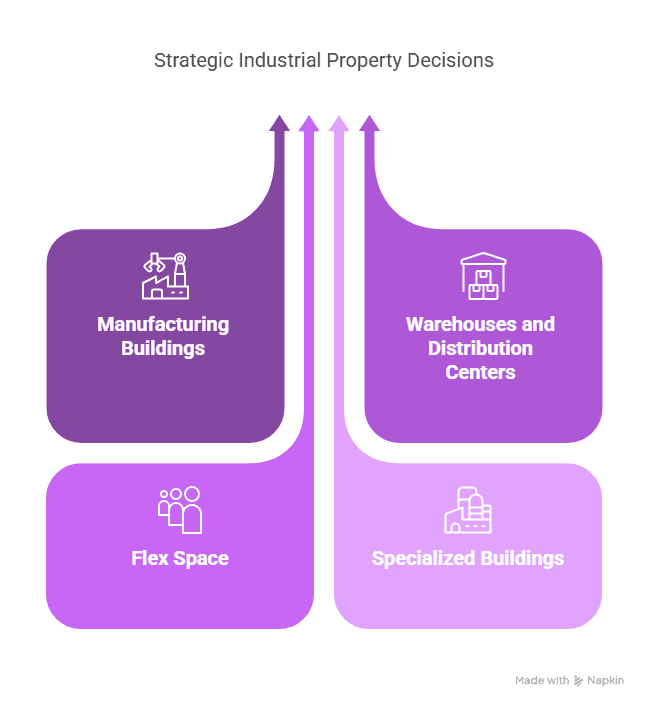
Manufacturing Buildings: High-Value Industrial Assets
Manufacturing facilities continue to be essential components in our industrial market. These specialized buildings offer the infrastructure production businesses need: spacious floor plans, appropriate ceiling heights, reinforced floors to support equipment, and strategic loading areas.
For Property Owners
If you own manufacturing space, you’re holding increasingly valuable assets in today’s market. Properties with updated power systems (especially 3-phase), modern HVAC, and well-maintained loading areas command premium rents from qualified tenants.
Vacant manufacturing space often benefits from targeted improvements. Rather than costly complete renovations, strategic upgrades to power distribution, loading docks, or floor reinforcement can significantly enhance marketability and justify higher rates.
For Manufacturing Businesses
Finding the right manufacturing facility means aligning building specifications with your actual production requirements. I help clients identify properties that meet their technical needs without overpaying for unnecessary features.
Key considerations include:
- Power capacity and distribution appropriate for your equipment
- Floor load ratings that accommodate your machinery
- Ceiling heights that work for your processes
- Loading configurations that support your supply chain
- Zoning that permits your specific manufacturing activities
Warehouses and Distribution Centers: Finding Your Perfect Match
In my 15+ years helping clients with industrial properties, I’ve developed a keen eye for what makes warehouse space work for different operations.
General Warehouses offer that versatile foundation most businesses need. I recently helped a home goods distributor secure a 45,000 sq ft general warehouse that perfectly balanced accessibility and affordability.
Cold Storage Facilities remain the gold standard for food and beverage companies. The built-in temperature control systems that might seem basic to you could be worth their weight in gold to the right tenant.
Hazardous Material Warehouses with their specialized containment systems are rare finds in our market. If you own one, you’re holding an asset that commands premium rates from chemical and industrial clients.
Specialized Warehouses designed for unique products create incredible value for the right user. I helped a fine art storage company find a humidity-controlled facility that saved them over $200K in retrofit costs.
Distribution Warehouses with their focus on flow efficiency can dramatically impact your bottom line. The right layout can reduce your handling costs by 15-20% compared to adapted space.
If you own warehouse property with premium features like ESFR sprinklers or clear heights over 28′, you’re sitting on exactly what my clients are hunting for. These aren’t just nice-to-have features—they’re lease-extending, rate-increasing advantages I can leverage to bring you quality tenants.
If your business relies on efficient inventory management, I’ll find you space that works as hard as you do. The right warehouse isn’t just about storage—it’s about streamlining your entire operation.
Flex Space
I’ve seen firsthand how flex spaces have transformed the industrial market over the past decade. These adaptable buildings give you that perfect blend of office, production, and storage under one roof—ideal for operations that don’t fit neatly into traditional categories.
If you own a flex property, you’re sitting on what many of my clients are actively seeking right now. The businesses driving today’s market—especially those in tech-adjacent fields and light manufacturing—are willing to pay premium rates for well-designed flex space. I recently helped a property owner in Commerce reposition their basic warehouse as flex space, resulting in a 22% increase in lease rate.
If your business needs versatile space, I’ve got a track record of creative solutions. Just last quarter, I helped a specialty food producer convert a standard industrial unit into a certified commercial kitchen with adjoining office space. Another client transformed a simple warehouse into a sophisticated cannabis packaging facility with climate-controlled storage. These conversions delivered exactly what these businesses needed without the premium of purpose-built facilities.
The beauty of flex space is that it grows with you. Let’s talk about how I can either market your flex property to these hungry tenants or find you the adaptable space your business needs to thrive.
Data Centers, R&D Facilities, and Specialized Buildings
Beyond the standard industrial categories, the Los Angeles market offers specialized industrial properties including:
- Data centers with cooling systems and uninterruptible power
- Research and development facilities for tech and biotech companies
- Truck terminals strategically located near transportation corridors
- Showrooms for businesses needing display and storage space
For property owners: These specialized properties require targeted marketing to the right tenant base. My deep industry connections can help you identify and secure tenants seeking your property’s unique features.
For businesses: Finding these specialized spaces often requires an insider’s knowledge of the market. I can help you uncover off-market opportunities that perfectly match your requirements.
What Drives Property Value in Today’s Market
From my experience across the Los Angeles industrial market, the most valuable buildings aren’t just defined by their specifications—they’re defined by location and how business-friendly the local municipality is.
Key value drivers include:
| Value Driver | Impact |
|---|---|
| Prime Location | Proximity to major freeways (5, 710, 110, and 10) significantly boosts value |
| Building-to-Lot Ratio | Properties with yards or excess land command premium prices |
| Modern Construction | Concrete tilt-up buildings with high clear heights attract quality tenants |
| Power Capabilities | Heavy power (3-phase or more) essential for manufacturing tenants |
| Fire Systems | Existing sprinkler systems, especially ESFR, reduce tenant improvement costs |
| Business-Friendly Cities | Locations with streamlined permitting processes maintain higher values |
Successful Property Conversions and Adaptations
I’ve seen quite a few successful industrial building conversions here in Los Angeles that demonstrate how flexible and valuable these properties can be when properly reimagined.
One standout example is a former garment warehouse in downtown L.A.’s Arts District that was transformed into a mixed-use industrial showroom with modern offices in front and small-batch production in the back for a growing e-commerce apparel brand. Strategic upgrades—HVAC improvements, polished concrete floors, and new glass roll-up doors—made the space highly desirable and quickly leased.
Another example in Vernon involved converting a cold storage facility into a refrigerated food distribution hub for a specialty Chinese produce importer. By reconfiguring the racking layout, upgrading insulation, and improving truck circulation, the business cut delivery times, expanded operations, and gained full control over its supply chain.
Current Market Opportunities
In the current market, larger institutional players that were once pursuing 200K+ square foot properties have become more cautious due to interest rates. This has created opportunities for owner-users and smaller investors to act. SBA and conventional financing, while not as affordable as before, is still facilitating deals in the 6–7% range.
Leasing data confirms what we’re experiencing on the ground. According to AIR CRE and Moody’s Analytics, activity in larger spaces—75,000 square feet and up—has slowed significantly. But deals in the sub-50K range have remained steady, if not growing.
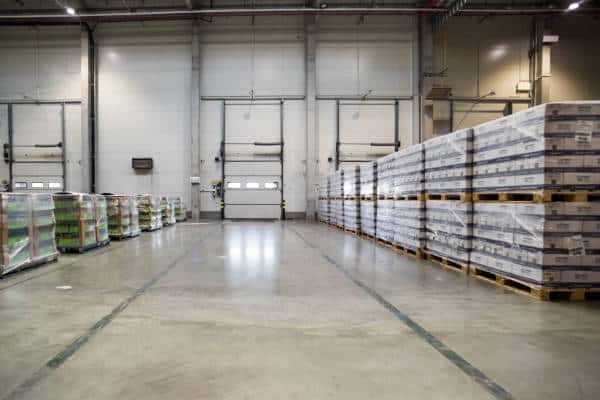
Property Conversions in Los Angeles: Transforming Real Estate for Higher Returns
The Los Angeles commercial real estate market has become a laboratory for innovative property conversions, where savvy investors are transforming underutilized buildings into high-demand assets. These adaptive reuse projects aren’t just generating impressive returns—they’re addressing critical urban challenges while breathing new life into the city’s built environment.
The Office-to-Industrial Revolution
Los Angeles faces an acute shortage of industrial space, creating compelling opportunities for investors willing to think creatively about existing assets. Atlas Capital’s recent $39.8 million acquisition of a 94,113-square-foot office building exemplifies this trend perfectly. Rather than competing in an oversaturated office market, they recognized the potential to transform this property into a Class A industrial facility.
The economics are compelling. Industrial properties in LA command premium rents and maintain strong occupancy rates, driven by the region’s position as a major logistics hub and the constraints of developable land. When you can repurpose an existing structure to meet this demand, the potential for both rental income growth and asset appreciation becomes significant.
However, this transformation isn’t simply a matter of changing the tenant base. The conversion process requires navigating complex zoning changes to allow industrial use in areas previously designated for office space. The physical infrastructure demands are equally challenging—retrofitting a building designed for knowledge workers to accommodate freight operations means adding loading docks, reinforcing floors for heavier equipment, and ensuring adequate vehicular access for delivery trucks.
Construction costs can be substantial, but successful developers view these expenses as investments in dramatically improved rental rates and long-term asset value. The key lies in thoroughly analyzing the cost-benefit equation before committing to the conversion.
Creative Office Spaces: Industrial Heritage Meets Modern Needs
The transformation of mid-century industrial buildings in areas like El Segundo’s Smoky Hollow District tells a different story of adaptive reuse success. Here, developers recognized that tech companies and creative firms were seeking authentic, character-rich spaces that stood apart from generic office towers.
These industrial-to-office conversions capitalize on the unique aesthetic appeal of high ceilings, exposed structural elements, and open floor plans that creative tenants value. The result is rental rates that often exceed traditional office spaces, along with property values that reflect the desirability of these distinctive work environments.
The conversion process presents its own set of challenges. Parking requirements for office use typically far exceed those for industrial properties, often forcing developers to demolish existing structures or repurpose loading areas into parking lots. The industrial character that attracts tenants—freight doors, loading docks, utilitarian finishes—must be carefully balanced with the functionality and aesthetics expected in modern office spaces.
Building code compliance adds another layer of complexity. Transforming a space designed for manufacturing or warehousing into an environment suitable for office workers requires meeting stringent safety, accessibility, and occupancy standards. Successful developers work closely with architects and code specialists early in the planning process to identify potential obstacles and design solutions.
Residential Conversions: Addressing Housing Demand
Perhaps the most socially impactful conversions involve transforming commercial buildings into residential units. Developers like Jamison Properties have found success converting office buildings in neighborhoods such as Koreatown into multifamily housing, directly addressing Los Angeles’s persistent housing shortage.
These projects often benefit from municipal incentives designed to encourage affordable or mixed-income housing development. The financial returns can be attractive, particularly given the strong demand for urban housing, but the path to profitability requires careful navigation of significant challenges.
Construction costs for residential conversions are typically substantial—often around $350 per square foot—and current interest rates in the 8-9% range add pressure to project economics. Securing appropriate financing requires demonstrating both the technical feasibility of the conversion and the market demand for the finished product.
The physical transformation presents complex challenges. Converting spaces designed for commercial use into livable residential units requires extensive interior remodeling, often involving complete replanning of floor layouts, installation of kitchens and bathrooms, and upgrading building systems to serve residential rather than commercial needs.
Regulatory hurdles can be equally demanding. Zoning changes to allow residential use in commercial areas often require lengthy approval processes, and building code compliance for residential occupancy involves different standards than commercial uses. Successful developers build strong relationships with city planning departments and maintain realistic timelines that account for regulatory processes.
Keys to Conversion Success
The most successful property conversions in Los Angeles share several common characteristics. First, they respond to genuine market demand rather than theoretical opportunities. Whether it’s the need for industrial space, desire for creative office environments, or demand for urban housing, successful projects address real gaps in the market.
Thorough due diligence proves essential. This includes not just financial analysis but careful evaluation of zoning possibilities, building infrastructure capabilities, and construction requirements. Many seemingly attractive conversion opportunities become financially unviable once all costs and regulatory requirements are fully understood.
Successful developers also maintain realistic expectations about timelines and costs. Property conversions typically take longer and cost more than initially projected, so building appropriate contingencies into both schedules and budgets helps ensure project viability.
Finally, the most successful conversions leverage the unique characteristics of existing buildings rather than fighting against them. Whether it’s the robust structure of an old industrial building or the architectural character of a mid-century office complex, the best projects celebrate and enhance what makes each property distinctive.
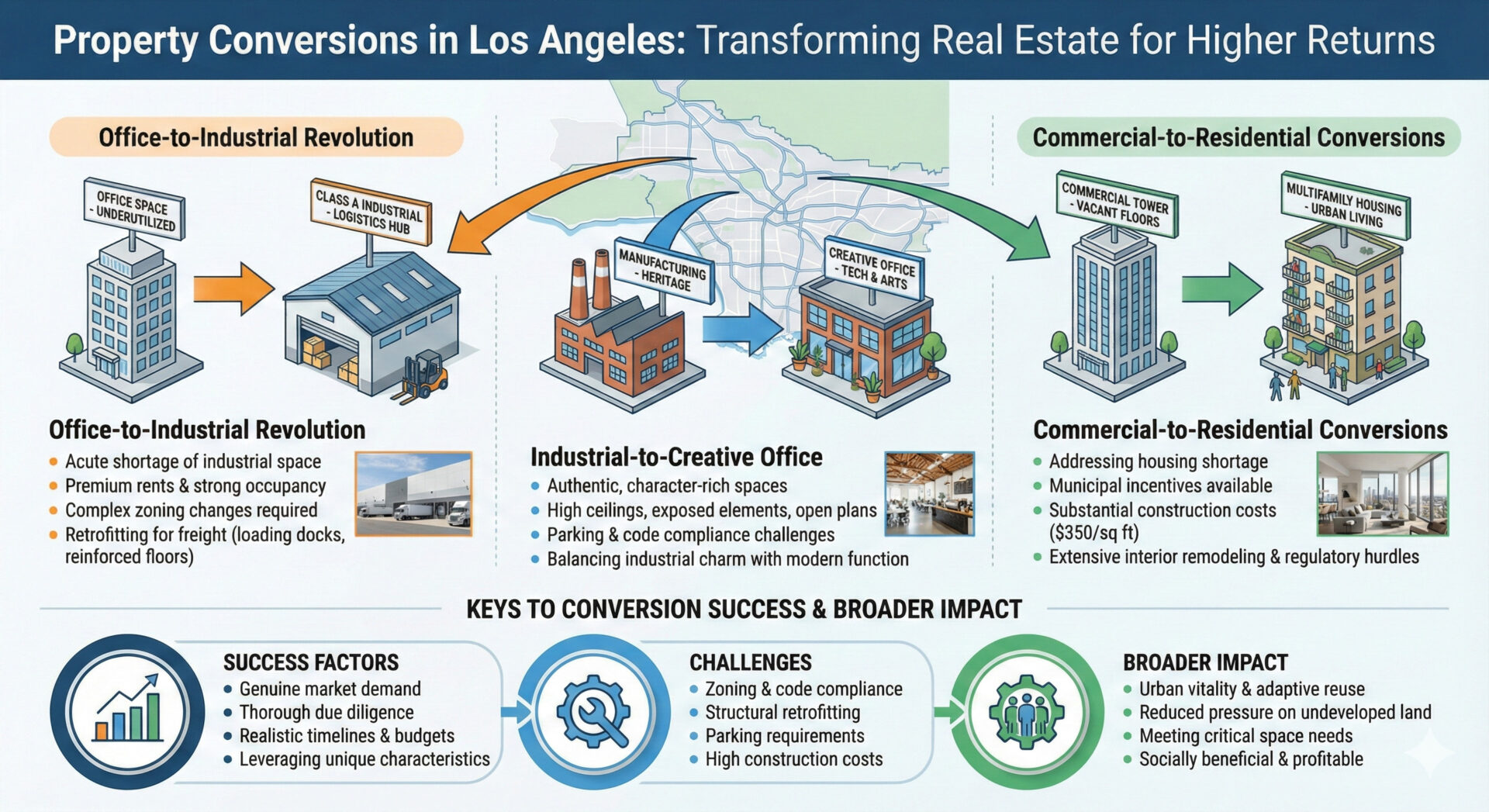
The Broader Impact
These conversion projects contribute to Los Angeles’s urban vitality in ways that extend beyond individual investment returns. By repurposing existing structures, they reduce pressure on undeveloped land while addressing critical needs for industrial space, creative offices, and urban housing.
The success of these projects demonstrates that adaptive reuse can be both profitable and socially beneficial. As Los Angeles continues to evolve, property conversions will likely play an increasingly important role in meeting the city’s changing real estate needs while generating attractive returns for investors willing to embrace the challenges and opportunities of transformation.
How I Can Help You Succeed in LA’s Industrial Real Estate Market
I bring years of experience in Los Angeles industrial real estate to help both property owners and businesses navigate this competitive landscape.
If you own industrial property, I’ll help you maximize its value through accurate valuation, targeted marketing to qualified prospects, and strategic negotiations. I’ll also guide you through upcoming regulatory hurdles like AB 98 and potential vacancy taxes.
For businesses seeking space, I’ll understand your unique needs, find properties that match (including hidden off-market gems), negotiate favorable terms, and help you identify business-friendly areas with compatible zoning. I’ll also help you plan for regulatory changes that could affect your operations.
My approach is relationship-based, focused on your long-term success rather than just closing deals. Let’s talk about your specific situation and how I can help you achieve your real estate goals in today’s challenging market.
FAQs
What types of industrial buildings are seeing the highest demand right now?
How will AB 98 affect my industrial property?
What should I do if I own a vacant industrial building?
What makes certain industrial buildings more valuable than others?
Is now a good time to sell my industrial property?
Conclusion
Look, we both know the LA industrial market is no walk in the park right now. Between these new vacancy taxes coming down the pipeline, shifting tenant demands, and regulations that seem to change weekly, it’s a lot for anyone to handle.
I’ve been in the trenches of this market for years, helping property owners just like you turn challenging situations into profitable opportunities. The same goes for business owners trying to find that perfect space without breaking the bank.
This isn’t just business for me – I’ve seen firsthand how the right industrial property decision can transform a company’s future or secure an owner’s retirement. I’ve also seen what happens when people try to navigate these waters without someone who knows where the hidden currents are.
Whether you’re sitting on a property that’s not performing as it should, or your business has outgrown its space and you’re worried about making an expensive mistake – let’s grab coffee (even just virtually) and talk it through. No pressure, no sales pitch – just straight talk about your specific situation and how we might tackle it together.
Schedule a consultation with me. You don’t have to figure this out alone.
